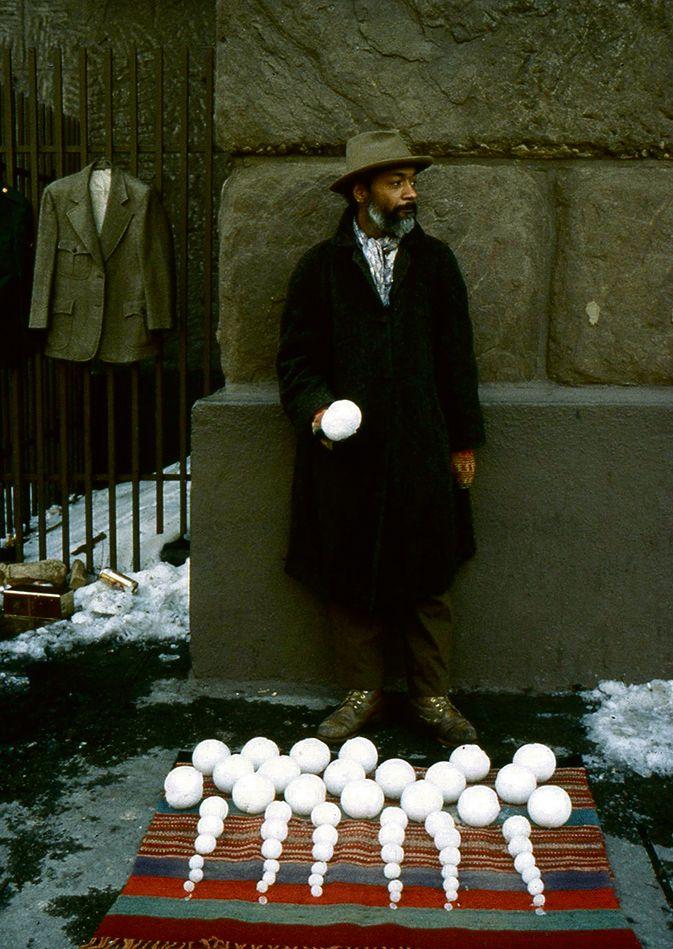The new documentary The Melt Goes On Forever: The Art and Times of David Hammons begins with a memory of Hammons selling snowballs on the pavement outside the Cooper Union in the winter of 1983. The snowballs were objects in a performance. A woman who thought she was helping a homeless man bought one and put it in her freezer in Queens. The film ends with the legacy today of one such snowball.
The documentary, by Judd Tully (a contributor to The Art Newspaper) and Harold Crooks, surveys Hammons’s artmaking over six decades, with appearances and disappearances of works of art, but mostly disappearances by the artist himself. The elusive Hammons, now 79, is sometimes called the Thomas Pynchon of the art world. He is not interviewed for the film and the filmmakers stress that they never asked him for an interview.
“This is not a biopic and it was never intended as a biopic,” Crooks says. He was reassured when someone attending an early screening said the audience was all but unaware that Hammons had not participated in the film.
The project involved an archaeology of probing the layers of people who interacted with a man who is now determined not to be seen. Hammons is present in his influence on multiple generations of artists, curators and critics.
The project took ten years to assemble, and it took Tully and Crooks to Los Angeles, where Hammons lived and studied as a young man. His influential mentor there was the artist and professor Charles White. “It was in 1965 after the Watts Riots that Charles White became the first non-white [artist] to teach at Otis [Art Institute]. And the story of his students begins then,” the curator Ilene Susan Fort tells the filmmakers.
One of those students, Suzanne Jackson, remembers Hammons complaining that White “drew all over my drawing” and her replying: “He never did that to me, ’cause I can draw.” Jackson also remembers Hammons urging her to convert part of her studio into a gallery, which she did, reading off prices that were discounted to high double figures. Hammons would always return with more work to sell. “Every time there would be a next idea,” she says.
Crucial for Hammons was the Watts Rebellion of 1965 that began on 11 August with a Black man’s arrest for drunk driving. In six days, 3,400 people were arrested and 34 killed. Much of South Central Los Angeles, a community with a large African American population, had burned. For Hammons, an admirer of the French artist Marcel Duchamp, the neighbourhood was a ruin, but also an ominous expanse of readymades.
In 1966, the artists Noah Purifoy and Judson Powell organised 66 Signs of Neon, an exhibition of art assembled from materials found on the streets of Watts. The documentary shows work from that Los Angeles exhibition, and then shifts to the poet Steve Cannon, founder of A Gathering of the Tribes, a place for art and talk on the Lower East Side of Manhattan that is now shut. Cannon, who was blind and died in 2019, describes how Hammons picked up objects when he rode his bicycle downtown from Harlem. Standing in what was then his Harlem studio on 125th Street, Hammons explains in a rare video clip that “the objects that I use to make images from are from my community… and I call them culture sculptures, because they’re from the culture that grew up in today. The fruit doesn’t fall far from the tree. These are the fruits from the neighbourhood that I live in.”
Although eager to disappear from view personally, Hammons had a friend, the photographer Dawoud Bey, who documented much of his work—a crucial job, given the fragile materials involved. “So much of his work would have been literally invisible if it hadn’t been for the work of Dawoud Bey. Work would be on the street for a couple of days and then swept away,” Tully says. “Hammons was aware that he needed proof of these things that he had done. Dawoud was literally the lens for David Hammons’s work.”
As for the snowballs that Hammons sold on the street in the performance work Bliz-aard Ball Sale, photographed by Bey 40 years ago, audiences will see that Hammons gets the last laugh.
- The Melt Goes On Forever: The Art and Times of David Hammons, daily, Film Forum, New York

























